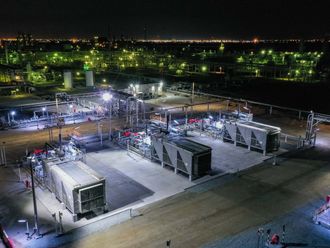
Chicago, New York, Houston: The US shale industry, gutted by two-and-a-half years of bankruptcies, writedowns, credit downgrades and layoffs, is poised to step back from the brink, thanks to an old enemy: Opec.
Abandoning a policy that sought to starve shale explorers and other high-cost drillers into submission, the Organisation of Petroleum Exporting Countries relented on Wednesday and agreed to curb output by 1.2 million barrels a day. Other producing nations that area’tmembers also signalled plans to cut back by as much as 600,000 barrels, Opec said.
The deal could boost prices through at least the first half of 2017, according to Chris Kettenmann, chief energy strategist at Macro Risk Advisors. The result: US shale fields could raise the amount of crude produced within four months, said Antoine Halff, at Columbia University’s Center on Global Energy Policy. First to pounce should be drillers in the Permian Basin of Texas and New Mexico, home to gushers prolific enough to spur a recent land rush.
Assuming the deal holds, “US oil production growth is all but guaranteed to return in 2017,” said Joseph Triepke, founder of Infill Thinking, a Dallas-based oil research firm, and a former analyst at Citadel LLC’s Surveyor Capital unit. “All US tight oil plays will benefit, but none more than the Permian, where we estimate as many as 150 rigs could be reactivated next year.”
Crude prices soared as much as 10 per cent in New York after the Opec agreement, and investors pushed energy companies into the top 18 spots on the Standard & Poor’s 500 index, swelling the US oil industry’s market value by $81.3 billion (Dh299 billion).
Some of the best performers were those hardest hit by the downturn that began in mid-2014 and accelerated five months later when Opec declined to reduce output. California Resources Corp. jumped by 44 per cent, while Halliburton Co., an oilfield services company, climbed as much as 15 per cent, its biggest intraday advance since 2008.
Bankrupt companies
Oilfield services that provide everything from $700 million floating rigs to the sand used by frackers have contributed the largest chunk of more than 350,000 oil industry layoffs globally during the two-year downturn. More than 100 oil service companies in North America have gone bankrupt.
Shale pioneer Harold Hamm, an energy adviser to President-elect Donald Trump, predicted as far back as 2014 that Opec would crack before the shale drillers. On Wednesday, Hamm found himself $3.1 billion richer as Continental Resources Inc., the company he leads, soared 23 per cent as his prediction came true.
“This is real and it is significant,” said Andrew Slaughter, executive director of Deloitte LLP’s Deloitte Center for Energy Solutions in Houston and a former Royal Dutch Shell Plc executive. “Even if they don’t deliver the full 1.2 million-barrel cut, it accelerates the inventory drawdown.”
Financial hedges
Over the next few months, drillers will likely take advantage of the recent price bump, moving to lock in profits on future production with financial hedges, according to Halff, the director of global oil markets research at Columbia and a former chief oil analyst at the International Energy Agency.
Not everyone sees only upside. Natural gas producers may be victimised, said Jason Schenker, president of Prestige Economics LLC in Austin, Texas. As oil drilling ramps up, more gas will flow out of the ground along with it, he said, threatening to derail a rally that pushed US prices for the furnace and factory fuel to a 2-year high.
“These guys will drill more, and you are going to get that extra gas at an inconvenient time,” Schenker said. “It’s bearish for US gas for the next three- to nine-month window.”
Other analysts suggested Opec may have a deeper motive, pushing a bump now but looking to drive down the future price of oil. That would hinder shale producers from getting financing for drilling based on the prospect of rising prices, said Michael Roomberg, who helps manage $7.5 billion at Miller Howard Investments Inc. in Woodstock, New York.
‘Clever strategy’
“The six-month term of the deal seems like a clever strategy designed to limit upside in the forward curve which will inhibit some market share gains by US shale while at the same time increasing current Opec revenue,” Roomberg wrote in an email.
Others preached caution. Investors should avoid “sharp recovery hype,” Matt Marietta, a Stephens Inc. analyst in Houston, told clients in a research note Wednesday.
“We reiterate our view that structurally oversupplied crude markets will take more time to balance,” Marietta wrote. “The math suggests an ongoing imbalance is likely to persist well into 2017, even with an OPEC cut, and no US growth.”
The strength of the deal will also depend on whether all parties deliver on their commitment. Saudi Arabia and its Gulf allies, the UAE and Kuwait, have traditionally stuck to their cuts, but some others haven’t, particularly when prices are low. Any doubt in the market could once again see prices come under pressure.
Price forecast
Moody’s Corp., for one, isn’t changing its oil price forecasts for next year. “Opec agreements are difficult to implement and difficult to enforce,” wrote Terry Marshall, a Moody’s Senior Vice President, in a report to investors.
Mostly, though, analysts outlined consequences from OPEC’s agreement that will be positive and vast. For the global energy industry, which has endured the most painful downturn in a generation, the deal means companies from Exxon Mobil Corp. in the US to Total SA in France may loosen their belt-tightening while countries that depend on oil for revenue may finally see an end ahead to their struggles.
Latin American producers including Columbia’s Ecopetrol SA and Brazil’s Petroleo Brasileiro SA will see pretax earnings rise 3 per cent and 2 per cent, respectively, for every $1 rise in oil prices, Bank of America Merrill Lynch analysts Frank McGann and Vicente Falanga Neto said in a note to clients. Canadian oil sands producers, who have some of the most expensive production in the world, could also gain.
The Opec announcement “is certainly near-term positive,” said Newfield Exploration Co.’s Chairman and Chief Executive Officer Lee Boothby in a Bloomberg Television interview. “As you move up the price curve and you get more confident of the outlook for future pricing, we’ll be able to add activity as cash flows grow.”
— Bloomberg












